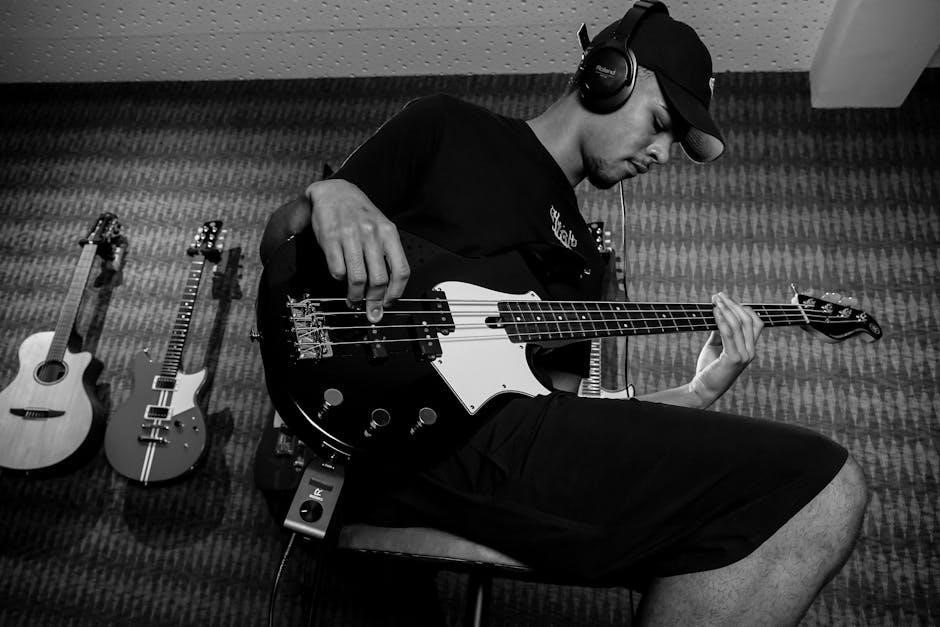The bass guitar is a foundational instrument in music, providing rhythm and harmony. For beginners, understanding its role, parts, and basic techniques is essential. PDF guides offer detailed lessons on anatomy, tuning, and playing notes, making learning accessible and structured. These resources often include fretboard charts, exercises, and tips for effective practice. Start with the basics to build a strong foundation and progress smoothly in your musical journey.
1.1. The Role of a Bass Guitarist
The bass guitarist plays a crucial role in a band, serving as the foundation of the rhythm section. They provide the low-pitched harmonic and rhythmic support that underpins the music. The bassist works closely with the drummer to create a solid groove, ensuring the song’s timing and feel are consistent. Root notes are often emphasized, as they define the chord progression and give the music its harmonic structure. A skilled bassist must listen actively, adapt to the band’s dynamics, and maintain a steady rhythm. While the role may seem supportive, it is vital for anchoring the music and enabling other instruments to shine. Understanding this role is key for beginners to develop their skills effectively.
1.2. Parts of the Electric Bass Guitar
The electric bass guitar consists of several key components that are essential for its function and playability. The fretboard, a long, flat piece of wood, is where the strings are pressed to produce notes. The strings, typically four in number, are plucked or strummed to create sound. At the top of the neck, the tuning pegs are used to adjust the string pitches. The bridge at the base of the body holds the strings in place and allows for height adjustment; Pickups, magnetic devices under the strings, capture the vibrations and send them to the amplifier. The tone and volume controls on the body adjust the sound’s brightness and loudness. Finally, the amplifier and speaker amplify the sound for others to hear. Understanding these parts is crucial for setup, maintenance, and effective playing.

Setting Up and Tuning
Setting up your bass guitar involves selecting the right instrument, proper holding techniques, and tuning. Use standard tuning (E-A-D-G) for consistency. Adjust the bridge and strings for optimal playability, ensuring comfort and clear tone. Amplifier basics, including volume and tone controls, help customize your sound. Regular tuning and setup maintenance are essential for beginners to develop good habits and achieve the best sound quality possible. This foundational step ensures your bass is ready for effective practice and performance.
2.1. Selecting the Right Bass Guitar
Selecting the right bass guitar is a crucial step for beginners. Consider a 4-string bass for its simplicity and versatility. Choose between fretted or fretless based on your preference for tone and playability. Acoustic, electric, and upright basses offer different sounds and playing experiences. Ensure the bass is the correct size for your body, as full-size and short-scale options are available. Test the action (string height) and neck width for comfort. Tone preferences may lead you to models with single-coil or humbucker pickups. Budget-friendly options are available without compromising quality. Consult PDF guides for detailed comparisons and recommendations to find the best fit for your needs and style. This decision will significantly impact your learning and playing experience.
2.2. Holding the Bass Guitar
Holding the bass guitar correctly is essential for comfort and proper technique. When sitting, rest the bass on your left leg, with the neck at a slight upward angle. Use a strap to support the instrument, ensuring it’s balanced and not too low. Stand with good posture, keeping the bass at a comfortable height, and adjust the strap so the neck is parallel to the floor. Your left hand should support the neck lightly, while your right hand plucks the strings. Maintain a relaxed posture to avoid fatigue and ensure smooth playability. Proper holding techniques are covered in detail in PDF guides, emphasizing comfort and ergonomics for beginners. This setup allows for efficient finger movement and optimal sound production.
2.3. Tuning the Bass Guitar
Tuning the bass guitar is a fundamental skill for every beginner. The standard tuning for a 4-string bass is E-A-D-G, from lowest to highest pitch. Use a tuner or reference pitch to ensure accuracy. Start with the E string, pluck it open, and adjust the corresponding tuning peg until the needle stabilizes. Repeat this process for the A, D, and G strings. PDF guides often include step-by-step instructions and visual aids to help memorize the process. Regular tuning is crucial for maintaining clear tone and proper intonation. Beginners should practice tuning regularly to develop muscle memory and confidence. This skill forms the basis of all playing techniques and ensures your bass sounds in harmony with other instruments.
2.4. Amplifier Basics
An amplifier is essential for projecting the bass guitar’s sound. Beginners should understand the basics of how it works. The amplifier consists of a preamp, power amp, and speaker, working together to boost the instrument’s signal. PDF guides often include tips on setting up and using an amp effectively. Start by connecting the bass to the input, adjusting the volume and EQ controls to achieve a clear, balanced tone. Experiment with different settings to find the sound that suits your style. Proper amplifier use enhances your playing experience and ensures your bass is heard clearly in any setup. Learning these basics will help you optimize your sound and enjoy playing more confidently.

Basic Playing Techniques
Mastering basic techniques is crucial for beginners. Learn proper posture, hand positioning, and fingering to play cleanly. Focus on developing a consistent practice routine to build muscle memory and improve dexterity.
3.1. Hand Positions and Posture
Proper hand positioning and posture are essential for comfortable and effective bass playing. Sit or stand with the bass held securely, balancing its weight evenly. For sitting, rest the instrument on your left leg, with the neck slightly angled upwards. When standing, adjust the strap so the bass hangs at a comfortable height, allowing easy access to the fretboard. Your left hand should support the neck lightly, with fingers placed close to the fretboard for precise note pressing. Your right hand should hover near the bridge, ready to pluck or strum strings with ease. Maintain good posture to avoid strain and ensure optimal playability. Proper alignment of hands and body helps produce clear, resonant tones and prevents fatigue during practice sessions.
3.2. Plucking Techniques
Plucking is a fundamental technique for bass guitar, offering dynamic control and tonal variety. Start by using your index and middle fingers, plucking strings with the pads or tips for different tones. Experiment with finger independence to improve accuracy and speed. Alternate fingers for smoother, consistent playing, especially in faster passages. Use your wrist to generate power, keeping your arm relaxed to avoid fatigue. For a brighter sound, pluck closer to the bridge; for a warmer tone, pluck near the neck. Practice plucking individual strings and chords to develop coordination. Begin with slow tempos and gradually increase speed as you gain confidence. Proper plucking technique lays the groundwork for expressive and precise bass lines, essential for any musical genre.
3.3. Basic Fingering and Positions
Mastering basic fingering and positions is crucial for playing the bass guitar effectively; Start by placing your left-hand fingers close to the fret, directly behind the string, to ensure clear notes. Use your index, middle, and ring fingers for most playing, reserving your pinky for occasional higher notes. Position your hand so your fingers can press the strings without muting adjacent strings. Begin with the E string (thickest string) and practice moving up the fretboard, focusing on accuracy. As you progress, learn to shift positions smoothly between notes. Proper fingering reduces fatigue and improves playability. Practice exercises like chromatic scales to build finger strength and dexterity. Consistent practice will help you develop muscle memory and confidence in your playing.
3.4. Damping Techniques
Damping is a crucial technique for controlling unwanted string noise on the bass guitar. It involves muting strings to prevent them from ringing out. For beginners, damping can be achieved using the palm or fingers; Lightly resting your palm on the strings near the bridge can mute them, while using your fretting-hand fingers to press strings firmly against the fretboard ensures silence. Practice damping immediately after playing a note to develop control. This technique is essential for maintaining clarity in your playing and is often used in genres like funk and jazz. Regular practice will help you master damping, enhancing your overall bass playing and allowing for more dynamic performances.

Understanding Music Theory
Understanding music theory is vital for bassists, focusing on notes, scales, and rhythm. It helps in identifying root notes and timing, enhancing your ability to play harmoniously and rhythmically.
4.1. Notes on the Fingerboard
Learning the notes on the bass guitar fingerboard is crucial for beginners. The bass fingerboard consists of four strings (E, A, D, G) with notes repeating every octave. Understanding note positions helps in playing scales, arpeggios, and melodies. PDF guides provide detailed fretboard charts, highlighting each note’s location, making it easier to memorize. These charts often include tips for identifying patterns and intervals. Starting with the open strings and moving up the frets, beginners can gradually master the layout. Regular practice and referencing these charts will enhance familiarity with the fingerboard, enabling smoother transitions and accurate playing. Downloadable fretboard charts and worksheets are excellent tools for systematic learning and memorization.
4.2. Basic Scales for Beginners
Mastering basic scales is essential for bass guitar beginners to build a strong musical foundation. Start with the major and minor scales, as they form the basis of most music. The major scale follows a specific interval pattern (W-W-H-W-W-W-H), while the minor scale differs slightly (W-H-W-W-H-W-W). Begin with the C major scale, focusing on proper fingering and note accuracy. Pentatonic and blues scales are also great for beginners, offering simplicity and versatility. These scales are widely used in various genres and can enhance your ability to create compelling bass lines. PDF guides often include scale charts and exercises, making learning structured and accessible. Regular practice will help you navigate the fingerboard confidently and improve your overall playing skills. Scales also aid in understanding chord progressions and improvisation, making them a vital part of your learning journey.
4.3. The Importance of Root Notes
Root notes are fundamental in bass playing, providing the harmonic foundation of a chord or key. They help establish the tonal center, making the music feel grounded and cohesive. For beginners, playing root notes is crucial as it ensures clarity in the rhythm section. Root notes also guide the listener’s ear, creating a sense of stability and direction. PDF guides emphasize the importance of identifying and playing root notes accurately. Regular practice helps develop muscle memory and improves timing. Understanding root notes is essential for effective communication within a band, allowing the bassist to support the melody and harmony seamlessly. Mastering root notes early on lays a solid foundation for more complex techniques and enhances overall musicality.

4.4. Basic Rhythm and Timing
Mastering basic rhythm and timing is vital for any bassist, as it ensures a tight, cohesive sound within a band. Rhythm provides the backbone of music, dictating how notes are played in relation to time. Beginners should focus on understanding note values, such as whole, half, and quarter notes, and rests. Practicing with a metronome helps develop a strong sense of timing. Listening to and mimicking professional bassists can also improve rhythmic accuracy. PDF guides often include exercises and backing tracks to help players apply rhythm in real-world scenarios. Timing accuracy allows the bassist to align perfectly with drummers and other musicians, creating a unified groove. Consistent practice and repetition are key to building this essential skill.

Practical Applications
Practical applications involve applying theory to real-world playing scenarios, such as performing in a band or with backing tracks. This helps develop timing, groove, and teamwork skills.
5.1. Playing Root Notes in a Band
Playing root notes is fundamental for bassists in a band setting, as they provide harmonic foundation and rhythm. Root notes align with the chord progression, ensuring cohesion. Beginners should focus on playing cleanly and in sync with the drummer. PDF guides emphasize the importance of root notes for maintaining structure. Practice with backing tracks helps develop timing and confidence. Listening to experienced bassists can inspire and guide your approach. Start with simple songs to build proficiency and gradually incorporate more complex rhythms. Consistent practice will enhance your ability to play root notes effectively, making you an indispensable part of any band.
5.2. Simple Bass Lines and Riffs
Simple bass lines and riffs are essential for beginners to develop their skills. Start by focusing on smooth transitions between notes, using scales and arpeggios as building blocks. Riffs often involve repetitive, rhythmic patterns that enhance a song’s groove. Practice playing along with backing tracks to improve timing and accuracy. PDF guides provide exercises and examples of basic bass lines, helping you learn by repetition. Listening to professional bassists and dissecting their lines can inspire your own playing. Remember, simplicity is key—many iconic bass lines rely on basic techniques executed well. With consistent practice, you’ll master the fundamentals and be ready to create your own riffs and lines, adding depth to any musical arrangement.
5.3. Playing Along with Backing Tracks
Playing along with backing tracks is a powerful way to apply your bass skills in real musical contexts. Start with tracks that match the keys and tempos of the scales and riffs you’ve practiced. This helps you develop timing, rhythm, and the ability to follow changes. Begin with slower tracks to build confidence, then gradually increase the tempo as you improve. Backing tracks also allow you to experiment with improvisation, using root notes and arpeggios to create your own lines. PDF guides often include exercises and tips for working with backing tracks effectively. Listening to professional bassists and emulating their playing can further enhance your learning. Regular practice with backing tracks will help you refine your technique and prepare you for live performance or collaboration with other musicians.

Advanced Techniques for Beginners
Explore arpeggios, slap and pop techniques, and interval playing to expand your musicality. These methods build on foundational skills, enhancing your versatility as a bassist.
Arpeggios are a fundamental technique in bass guitar, involving the playing of chord notes in succession. For beginners, starting with simple major and minor triads is recommended. These patterns help in understanding chord structures and improving finger dexterity. PDF guides often include exercises that break down arpeggios into manageable parts, making them easier to learn. Practicing arpeggios also enhances your ability to play melodic lines and solos. By mastering basic arpeggios, you can add complexity and depth to your bass lines, making your playing more engaging and versatile. Regular practice of these exercises will build confidence and skill, preparing you for more advanced techniques.
6.2. Basic Slap and Pop Techniques
Slap and pop techniques are essential for adding dynamic expression to your bass playing. Slapping involves striking the strings with your thumb, creating a percussive sound, while popping uses your fingers to pluck the strings sharply. These methods are often used in funk and R&B music. For beginners, start with slow, controlled motions to build coordination and avoid mistakes. PDF guides provide step-by-step lessons and exercises to master these techniques. Focus on proper thumb and finger positioning to achieve the desired tones. Practice these techniques with backing tracks to develop timing and rhythm. As you progress, incorporate slap and pop into simple bass lines to enhance your musical expression and versatility.

6.3. Playing Intervals and Chords
Playing intervals and chords on the bass guitar adds depth and complexity to your music. Start by understanding intervals, which are the spaces between notes. Practice major, minor, and perfect intervals by moving up or down the fretboard. Chords, typically played by plucking multiple strings simultaneously, can enhance your basslines. Focus on clean finger placement to avoid muting or producing unclear sounds. Begin with simple chord shapes and progress to more intricate ones. Timing is crucial, so practice with a metronome or backing tracks to improve rhythm. Incorporate exercises like arpeggios and scales in thirds to refine your technique. Stretching exercises can also aid in smoothly reaching intervals. Apply these skills in musical contexts to develop your bass playing effectively.

Learning Resources and Practice
Free PDF guides, fretboard charts, and rhythm worksheets are excellent tools for learning. Structured practice routines focusing on timing and technique are crucial. Use a metronome and incorporate scales, arpeggios, and play-along tracks to enhance your skills effectively.
7;1. Recommended PDF Guides for Beginners
PDF guides are an excellent resource for learning bass guitar, offering structured lessons and comprehensive coverage of essential topics. These guides typically include detailed sections on the anatomy of the bass guitar, notes on the fretboard, and basic music theory. Many PDFs provide exercises and worksheets to help memorize the fretboard and improve technique. They often cover fundamental skills such as plucking techniques, basic scales, and arpeggios. Additionally, some guides emphasize the importance of root notes and rhythm, providing practical examples and backing tracks for practice. These resources are ideal for self-paced learning, allowing beginners to grasp concepts at their own speed. Download free PDF guides to access fretboard charts, rhythm worksheets, and practice routines tailored for beginners.
7.2. Free Fretboard Charts and Worksheets
Free fretboard charts and worksheets are invaluable tools for bass guitar beginners, helping to memorize note positions and improve playing accuracy. These resources are often included in PDF guides and are readily available online without requiring registration. Fretboard charts provide a visual layout of the bass neck, highlighting notes across the frets, while worksheets offer exercises to practice scales, arpeggios, and basic music theory. Many charts include tips and tricks to accelerate the learning process. Worksheets often feature rhythms and timing exercises, allowing beginners to apply theoretical knowledge practically. By utilizing these resources, learners can enhance their understanding of the fretboard and develop essential skills in a structured and engaging manner. Regular practice with these materials ensures steady progress and a stronger grasp of the instrument.
7.3. Effective Practice Routines
Effective practice routines are crucial for consistent improvement on the bass guitar. Begin with short, focused sessions, gradually increasing duration as skills develop. Warm-ups, such as chromatic scales or simple exercises, prepare fingers and build dexterity. Dedicate time to timing exercises, using a metronome to enhance rhythm accuracy. Incorporate backing tracks to simulate real-band experiences, helping to develop timing and groove. Allocate specific days to technique, theory, and repertoire practice for balanced progression. Set clear, achievable goals for each session and track progress to stay motivated. Utilize free PDF guides for structured routines and exercises. Regular, disciplined practice ensures steady improvement and mastery of the bass guitar.

Staying Motivated and Improving
Set clear goals, track progress, and celebrate small achievements. Listen to professional bassists for inspiration and adapt their techniques to your practice. Stay consistent and enjoy the journey.
8.1. Setting Goals and Tracking Progress
Setting clear, achievable goals is crucial for steady improvement. Start with short-term objectives, like mastering a specific scale or technique, and gradually move to more complex challenges. Tracking progress helps maintain motivation and identifies areas needing attention. Use practice logs or apps to monitor improvement. Celebrate milestones to stay encouraged and maintain a positive mindset. Consistent practice and goal-setting will ensure you advance smoothly in your bass guitar journey.
8.2. Listening to and Learning from Bassists
Listening to experienced bassists is a powerful learning tool. Pay attention to their techniques, tone, and how they interact with the rest of the band. Analyze their playing styles to understand rhythm, phrasing, and note selection. Learning from bassists can inspire and guide your practice, helping you develop your own unique sound. Regularly studying their work will enhance your skills and broaden your musical understanding, making you a more versatile and confident bass player.
8.3. Overcoming Challenges and Staying Inspired
Learning to play the bass guitar can be challenging, but staying inspired is key to progress. Break difficult techniques into smaller, manageable steps and celebrate small achievements. Surround yourself with supportive resources, like online communities or practice buddies, to stay motivated. Embrace mistakes as part of the learning process and focus on consistent practice. Drawing inspiration from professional bassists and their journeys can reignite your passion. Remember, progress takes time, so set realistic expectations and enjoy the journey. Keeping a positive mindset and staying inspired will help you overcome challenges and continue growing as a bass player. Regularly exploring new music and techniques can also keep your practice fresh and exciting. Stay committed, and let your love for music guide your progress.
